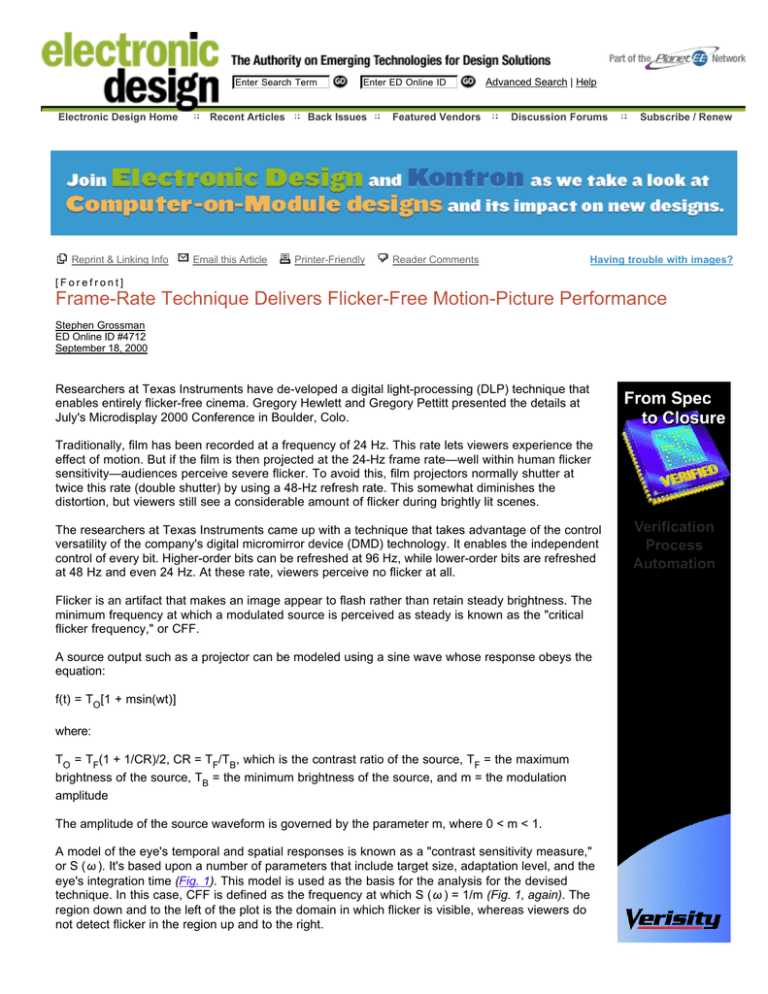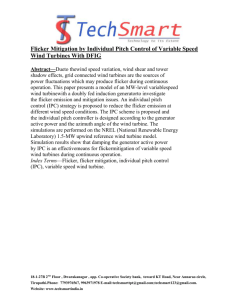
Enter Search Term
Electronic Design Home
Reprint & Linking Info
Recent Articles
Email this Article
Enter ED Online ID
Back Issues
Featured Vendors
Printer-Friendly
Reader Comments
Advanced Search | Help
Discussion Forums
Subscribe / Renew
Having trouble with images?
[Forefront]
Frame-Rate Technique Delivers Flicker-Free Motion-Picture Performance
Stephen Grossman
ED Online ID #4712
September 18, 2000
Researchers at Texas Instruments have de-veloped a digital light-processing (DLP) technique that
enables entirely flicker-free cinema. Gregory Hewlett and Gregory Pettitt presented the details at
July's Microdisplay 2000 Conference in Boulder, Colo.
Traditionally, film has been recorded at a frequency of 24 Hz. This rate lets viewers experience the
effect of motion. But if the film is then projected at the 24-Hz frame rate—well within human flicker
sensitivity—audiences perceive severe flicker. To avoid this, film projectors normally shutter at
twice this rate (double shutter) by using a 48-Hz refresh rate. This somewhat diminishes the
distortion, but viewers still see a considerable amount of flicker during brightly lit scenes.
The researchers at Texas Instruments came up with a technique that takes advantage of the control
versatility of the company's digital micromirror device (DMD) technology. It enables the independent
control of every bit. Higher-order bits can be refreshed at 96 Hz, while lower-order bits are refreshed
at 48 Hz and even 24 Hz. At these rate, viewers perceive no flicker at all.
Flicker is an artifact that makes an image appear to flash rather than retain steady brightness. The
minimum frequency at which a modulated source is perceived as steady is known as the "critical
flicker frequency," or CFF.
A source output such as a projector can be modeled using a sine wave whose response obeys the
equation:
f(t) = TO[1 + msin(wt)]
where:
TO = TF(1 + 1/CR)/2, CR = TF/TB, which is the contrast ratio of the source, TF = the maximum
brightness of the source, TB = the minimum brightness of the source, and m = the modulation
amplitude
The amplitude of the source waveform is governed by the parameter m, where 0 < m < 1.
A model of the eye's temporal and spatial responses is known as a "contrast sensitivity measure,"
or S (ω). It's based upon a number of parameters that include target size, adaptation level, and the
eye's integration time (Fig. 1). This model is used as the basis for the analysis for the devised
technique. In this case, CFF is defined as the frequency at which S (ω) = 1/m (Fig. 1, again). The
region down and to the left of the plot is the domain in which flicker is visible, whereas viewers do
not detect flicker in the region up and to the right.
The CFF is inversely proportional to the modulation amplitude (CFF = 1/m). Moving upwards at a
given frequency, the amplitude becomes smaller until curve S (ω) is reached, passing from the region of visible to not
visible flicker. In other words, the lower the value of m, the less it's likely that viewers will detect flicker.
Projection systems using the DMD as the modulation device generate output in the form of pulses of light. The CFF can be
computed for the pulses of light generated by film and DLP cinema projection. Unlike film, which generates various intensity
levels with amplitude modulation, the DMD uses pulse-width modulation. The duty cycle of the DMD varies from pixel to
pixel, thereby supplying the image to the viewer as it changes at 24 Hz. Yet the refresh rate doesn't have to be confined to
24 Hz. It can be delivered at higher rates, depending on the significance of each bit.
Each single pixel has two intensities—46% and 62.5%—for a single refresh period (1/frame rate) (Fig. 2). Successive bits
consume progressively more of the total refresh interval. Each successive bit has twice the previous duration, from the
least significant bit (LSB) to the most significant bit (MSB).
A Flicker-Free Rate
Figure 3 illustrates a case where four refresh cycles occur in 1/24 s. This is a refresh rate of 96 Hz (or a cycle time of 1/96
s). If a refresh rate of 96 Hz could be utilized, there would be no flicker. Due to the limitations of the DMD, though, LSBs of
2.5-µs duration would be necessary to achieve 12-bit resolution. But the DMD technology requires that all bits be at least 10
µs in duration. So, there is a tradeoff between the operating refresh rate and the length of the LSB. If the operating refresh
rate is too high, the LSB becomes too short. Likewise, if the operating refresh rate is too low, viewers detect flicker.
The solution lies in the fact that each bit is displayed entirely independently from every other bit. The DLP electronic
system has been designed so bit sequences are programmable according to an independent bit-by-bit specification. Users
are free to display the given bits of the 24-Hz source so the MSBs can be shown at multiples of 24 Hz (48, 72, or 96 Hz or
greater), while the LSBs can be shown at a refresh rate as low as 24 Hz.
Using the temporal sensitivity model, each of the bit durations can be mapped on the sensitivity curve (Fig. 4). The 10-µs
pulses can operate at 24 Hz to avoid flicker, whereas a 200-µs pulse would have to be refreshed at 48 Hz or higher to be
flicker-free.
Frame-rate by bit-significance, from LSB to MSB, is tabulated in the table. Bits of successively longer durations need to be
refreshed at the higher bit rates to prevent flicker.
Moviegoers may be used to flicker. But the DLP projector provides, for the first time, a solid perceived image that gives
audiences a flicker-free cinematic experience. For more information, go to www.ti.com/dlp or www.dlpcinema.com.
READER COMMENTS:
We want to hear what you have to say about this article!
Tell us what you think - post your comments here.
Name (required):
Email
Your email is only used if our editors need to contact you.
"
PlanetEE Marketplace
Introducing TI's TS Switches
TI's new analog and specialty switch portfolio. Free Samples.
Harbour Industries Cable Coach
A tool to help you choose the right coax for your application.
MLC NAND Flash Memory from Toshiba
Get the facts on MLC vs. SLC NAND in a free MLC Application Note
Wireless M2M White Paper
Using 802.11b in Remote M2M and Industrial Control Applications
Cadence seminar and workshop
Attend a Cadence Encounter low power design flow seminar & workshop
Atmel (R): total security solutions
Learn about our products and qualify for a free development kit.
DigiKey.com - Unparalleled Service
Access more than 400,000 parts from over 300 vendors
Ads by Google
Nevrokard LT-HRV
Security Design System
Prototyping
FlexPro 6 Software
Download advanced HRV software
for analysis of long-term Holter files
Giotto high security design system
SLA, SLS, FDM, Prototyping
resources and solutions.
Data Analysis and Presentation AR,
ARMA, Eigen Spectral Estimators
www.nevrokard.medistar.si
www.pitagora.ch
www.businessranks.com
www.weisang.com
Planet EE Network Home | Contact Us | Editorial Calendar | Media Kit | Site Feedback & Bugs
Copyright © 2004 Penton Media, Inc., All rights reserved. Legal | Privacy





